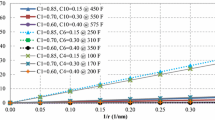Abstract
Positive velocity dependency of relative permeability of gas–condensate systems, which has been observed in many different core experiments, is now well acknowledged. The above behaviour, which is due to two-phase flow coupling in condensing systems at low interfacial tension (IFT) conditions, was simulated using a 3D pore network model. The steady-dynamic bond network model developed for this purpose was also equipped with a novel anchoring technique, which was based on the equivalent hydraulic length concept adopted from fluid flow through pipes. The available rock data on the co-ordination number, capillary pressure, absolute permeability, porosity and one set of measured relative permeability curves were utilised to anchor the capillary, volumetric and flow characteristics of the constructed network model to those properties of the real core sample. Then the model was used to predict the effective permeability values at other IFT and velocity levels. There is a reasonable quantitative agreement between the predicted and measured relative permeability values affected by the coupling rate effect.
Similar content being viewed by others
References
Alvi, S. H., Sridharan, K. and Lakshmana Rao, N. S.: 1978, Loss characteristics of orifices and nozzles, J. Fluid Engng 100, 299–307.
Baldwin, C. A., Sederman, A. J., Mantle, M. D., Alexander, P. and Gladden, L. F.: 1996, Determination and characterization of the structure of a pore space from 3D volume images, J. Coll. Inter. Sci. 181(1), 79–92.
Blom, S. M. P. and Hagoort, J.: 1998, How to include the capillary number in gas–condensate relative permeability functions, in: Proceedings of the 73rd SPE Annual Technical Conference and Exhibition, SPE 49268, New Orleans, LA, pp. 957–967.
Blunt, M. and King, P.: 1991, Relative permeabilities from 2-dimensional and 3-dimensional porescale network modeling, Transport in Porous Media 6(4), 407–433.
Dullien, F. A. L.: 1992, Porous Media, Fluid Transport and Pore Structure, Academic Press, San Diego, CA, pp. 11–14, 58.
Edwards, M. F., Jadallah, M. S. M. and Smith, R.: 1985, Head losses in pipe fittings at low Reynolds number, Chem. Engng Res. Des. 63, 43–50.
Fischer, U. and Celia, M. A.: 1999, Prediction of relative and absolute permeabilities for gas and water from soil water retention curves using a pore-scale network model, Water Resour. Res. 35(4), 1089–1100.
Henderson, G. D., Danesh, A., Tehrani, D. H. and Peden, J. M.: 1995, The effect of velocity and interfacial tension on relative permeability of gas–condensate fluids in the wellbore region, in: Proceedings of the 8th European IOR Symposium, Vienna, pp. 201–208.
Henderson, G. D., Danesh, A., Tehrani, D. H., Al-Shaidi, S. and Peden, J. M.: 1998, Measurement and correlation of gas–condensate relative permeability by the steady-state method, SPE Reser. Eval. Engng 1(2), 134–140.
Henderson, G. D., Danesh, A. and Tehrani, D. H.: 2001, Effect of positive rate sensitivity and inertia on gas–condensate relative permeability at high velocity, Petrol. Geosci. 7(1), 45–50.
Hoshen, J. and Kopelman, R.: 1976, Percolation and cluster distribution, I. Cluster multiple labelling technique and critical concentration algorithm, Phys. Rev. B 14(8), 3438–3445.
Ioannidis, M. A. and Chatzis, I.: 1993, Network modeling of pore structure and transport-properties of porous-media, Chem. Engng Sci. 48(5), 951–972.
Jamiolahmady, M.: 2001, Mechanistic model of gas–condensate flow in porous media, PhD Thesis, Petroleum Engineering Department, Heriot-Watt University, Edinburgh, UK, pp. 74–103.
Jamiolahmady, M., Danesh, A., Tehrani, D. H. and Duncan, D. B.: 2000, A mechanistic model of gas–condensate flow in pores, Transport in Porous Media 41(1), 17–46.
Lin, C. and Cohen, M. H.: 1982, Quantitative methods for micro-geometric modeling, J. Appl. Phys. 53(6), 4152–4165.
Lymberopoulos, D. P. and Payatakes, A. C.: 1992, Derivation of topological, geometrical, and correlational properties of porous-media from pore-chart analysis of serial section data, J. Coll. Inter. Sci. 150(1), 61–80.
Mathews, T., Matthews, G. P. and Huggett, S.: 1999, Estimating particle size distributions from a network model of porous media, Powder Technol. 104(2), 169–179.
Matthews, G. P., Moss, A. K., Spearing, M. C. and Voland, F.: 1993, Network calculation of mercury intrusion and absolute permeability in sandstone and other porous-media, Powder Technol. 76(1), 95–107.
McDougall, S. R.: 1994, Application of network modelling techniques to steady-and unsteady-state multiphase flow in porous media, PhD Thesis, Petroleum Engineering Department, Heriot-Watt University, Edinburgh, UK.
Netlib Repository at http://www.netlib.org, J. Dongarra and E. Grosse (eds), Maintained by AT & T Bell Laboratories, the University of Tennessee and Oak Ridge National Laboratory.
Portsmouth, R. L. and Gladden, L. F.: 1992, Mercury porosimetry as a probe of pore connectivity, Chem. Engng Res. Des. 70(1), 63–70.
Rajaram, H., Ferrand, L. A. and Celia, M. A.: 1997, Prediction of relative permeabilities for unconsolidated soils using pore-scale network models, Water Resour. Res. 33(1), 43–52.
Streeter, V. L. and Wylie, E. B.: 1983, Fluid Mechanics. McGraw-Hill, Tokyo, Japan, pp. 243–249.
Tsakiroglou, C. D. and Payatakes, A. C.: 2000, Characterization of the pore structure of reservoir rocks with the aid of serial sectioning analysis, mercury porosimetry and network simulation, Adv. Water Resour. 23(7), 773–789.
Valavanides, M. S., Constantinides, G. N. and Payatakes, A. C.: 1998, Mechanistic model of steadystate two-phase flow in porous media based on ganglion dynamics, Transport in Porous Media 30(3), 267–299.
Wang, X., Thauvin, F. and Mohanty, K. K.: 1999, Non-Darcy flow through anisotropic porous media, Chem. Engng Sci. 54(12), 1859–1869.
Wang, X. L. and Mohanty, K. K.: 2000, Pore-network model of flow in gas/condensate reservoirs, SPE J. 5(4), 426–434.
Author information
Authors and Affiliations
Rights and permissions
About this article
Cite this article
Jamiolahmady, M., Danesh, A., Tehrani, D. et al. Positive Effect of Flow Velocity on Gas–Condensate Relative Permeability: Network Modelling and Comparison with Experimental Results. Transport in Porous Media 52, 159–183 (2003). https://doi.org/10.1023/A:1023529300395
Issue Date:
DOI: https://doi.org/10.1023/A:1023529300395




